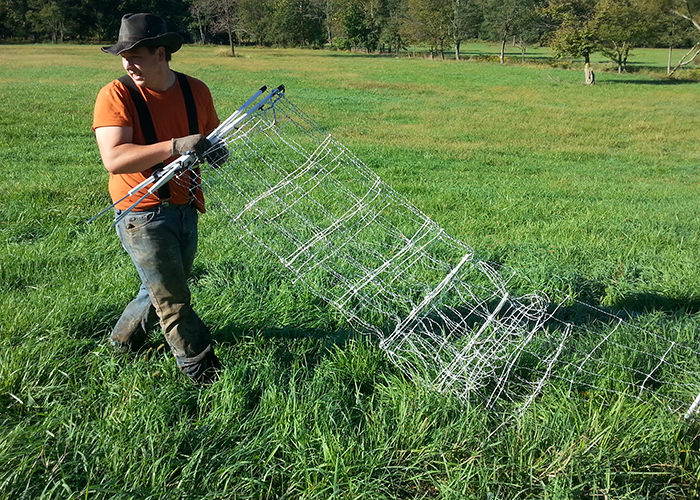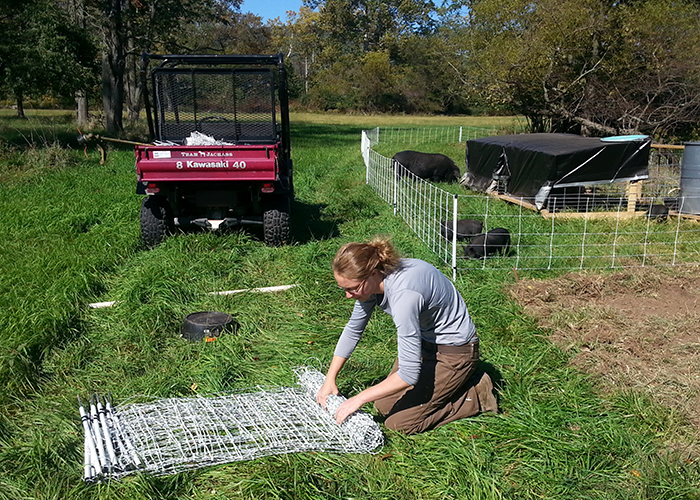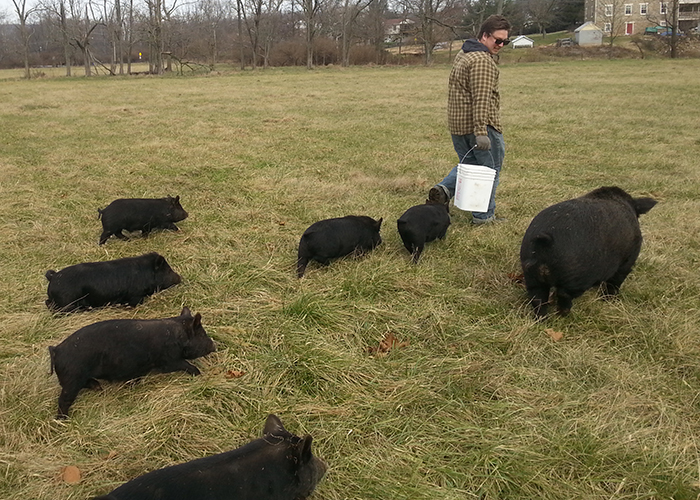Getting Started with Pastured Pigs
By Nicole Luttrell, Wild Song Farm
The way animals are raised should reflect their natural habits. For pigs, that means access to forage such as grass, legumes, roots, and grubs and space to exercise their muscles and minds. By rotating pigs regularly on pasture and woodland edges, we can satisfy their needs while breaking cycles of fecal parasites and saving money on feed costs. In return, we receive more flavorful meat that is higher in vitamins and nutrients such as omega-3 fatty acids.
Raising pigs on pasture is an interesting trade-off. You must commit to rotating the hogs to fresh pasture regularly, a task that takes effort and time. In exchange, the pigs take on more of the work load by foraging some portion of their food and spreading their own manure. The easier it is to move pigs to fresh pasture, the more efficient, profitable, and enjoyable your pastured pig operation.

Wild Song Farm has seen many benefits from grazing their American Guinea Hogs on pasture: Healthier animals, enhanced parasite management, improved soil fertility, reduced feed costs and more nutritious meat.

Thomas lays out the Pig QuikFence® fencing for a new paddock, being careful to drop the next post only once the previous section is fully stretched out.

Thomas prepares to let the pigs into the new paddock. By aligning the end posts of both paddocks, we can easily create an opening by pulling back a section from each fence.
Fencing Options
Fencing makes up a sizable chunk of the start-up expense. We chose Pig QuikFence®, a net of polywire (conductive wires twisted with plastic strands) attached to posts at regular intervals. Do-it-yourself multi-strand polywire fencing is often less expensive but can be more cumbersome to set up. However, we like the tighter spacings of the Pig QuikFence® for small piglets.

The piglets eagerly enter a new paddock to forage on fresh pasture. The previous paddock was about 80% rooted. With some seeding of timothy grass, winter oats, and rye, it greened up nicely by late fall.
For a group of 8 pigs, we recommend creating paddocks using two to four 100’ fences and having extra rolls on hand for setting up new paddocks. Frequency of pasture rotations varies with weather, paddock size, number of pigs and forage quality. In our system it ranges from 4 days to 3 weeks. Observe pasture recovery and keep notes to improve pasture management.
Moving Day
Electric fencing is most effective when clear of grass and brush. When starting with tall grass, cut it with a weedwhacker, scythe, or mow along the intended fenceline before putting up the new fence.

For the first couple of moves, our boar required extra convincing to cross the electric fence line. Here a mulberry branch does the trick. Mulberry leaves are a beloved and nutritious forage for pigs.
Setting up and taking down electric netting is simple, if you do it right. Untie the bundle, hold onto the posts, and let the net hang down. Walk the new perimeter, dropping the next post of the fence once the previous section is stretched out. Once the fence is laid out, set up each post, making the net tight but not overly stretched. To charge our fence, we mount a solar energizer on a T-post, and connect it to a 3’ portable grounding rod and the fence at a junction point.
We usually set up a new paddock adjacent to the current one with the end posts from both fences meeting at one point. This makes it easy to pull aside one section of each fence to let the pigs into the new paddock.
Once your pigs are set up in their new paddock, take down the old fence to keep it safe from chewing critters. Pull out all of the posts and lay them down in place. Then walk the length of the fence, picking up posts while letting the net hang down. Once you have the posts in a bundle, lay down the fence on the ground, roll the net toward the posts, and tie to secure the roll. Store rolls indoors, off the ground and off shelves away from mice. Hanging from the ceiling is the best way to keep them safe.
Pigs are amazingly hardy animals, but they need shelter to live comfortably and gain weight. We started with shelters on skids built with lumber, hog panels and tarps. Later we graduated to a hay wagon shelter with overhanging metal roofing for shade and a 300 gallon IBC tote for on-demand water. The hay wagon shelter is easy to move with our UTV and is a good design for raising feeder pigs spring through fall.

Nicole rolls up a 100’ of Pig QuikFence®, starting from the net end and working toward the bundle of posts. Storing it in this way keeps it from getting tangled and makes the next set up much easier.

Nicole drags one of the mobile shelters to the next paddock. Skids on the bottom of the shelter make it easier to move over short distances. For long moves, we load the shelters onto a trailer and drive them to the next paddock.
Water and Wallows
Providing ample clean water to pigs on pasture is a challenge. For large operations, a water system that provides running water to all paddocks may be a worthwhile investment, but does pose problems in terms of maintenance and power outages. A water tank on a trailer may be an easier way to get started. Another option is setting up a permanent shelter area near running water with multiple adjacent paddocks. This can be a big time and energy saver, so long as you can manage the permanent area with woodchips to prevent it from getting too muddy, and find ways to keep parasite populations low by removing manure regularly and adding diatomaceous earth to the diet.

Thomas leads the pigs across the field to the winter paddock area. Moving pigs far distances without a fence is easy once you develop a relationship with the pigs. Buckets of apples help, too.
In hot weather, water must be available for wallowing. Pigs can’t sweat; instead they roll in mud and water to keep cool. Think strategically about where you are willing to allow wallows to develop on your property, as they can be a tripping hazard and make mowing difficult. In the hottest months, try to keep pigs in shadier paddocks.
Nicole Luttrell is a farmer, permaculture designer and freelance writer. She and her husband Thomas operate Wild Song Farm, a small permaculture-based farm and homestead in Thurmont, MD. She also offers landscape consultation and design services through Deeply Rooted Design, her edible and natural landscaping business. Visit www.wildsongfarm.usor www.deeplyrooteddesign.us to learn more.

